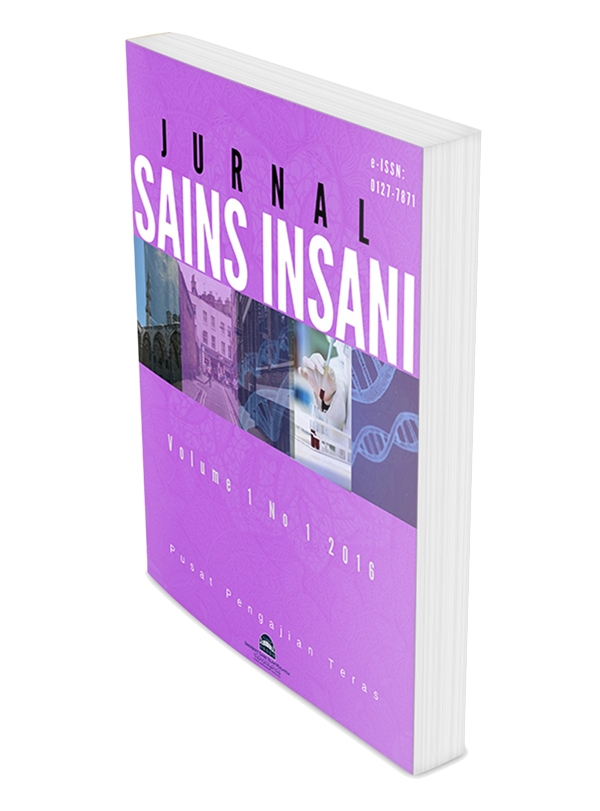Spouses Differences on Love and Commitment among Commuter Marriage
Perbezaan Cinta dan Komitmen dalam Kalangan Pasangan Perkahwinan Komuter
DOI:
https://doi.org/10.33102/sainsinsani.vol10no1.707Keywords:
Love, Commitment, Relationship, Commuter MarriageAbstract
Abstract: This study explored the differences between commuter marriage relationships in terms of love and commitment. A total of 110 respondents were involved, who are married individuals and who have a long-distance marriage with a partner. This study involved secondary and primary school teachers in Kota Kinabalu, Sabah, Malaysia. The study design is quantitative using a set of standard questionnaires to test the study variables. The Triangular Love Scale was used to measure love and the Investment Model Scale (IMS) was used to measure commitment variables. Pearson Correlation Analysis was used to analyse the relationship between love and commitment among commuter marriages. In contrast, the t-Test for Independent Samples was used to look at differences in love and commitment in terms of gender and the first marital status of respondents. Based on Pearson Correlation analysis, it was found that there is a significant relationship between love and commitment among commuter marriages (k = .335 **, p> .001). While the t-test for Independent Sample analysis between loves by gender found no significant differences, in contrast, commitment there was a significant mean difference between males and females. The results of this study found that there was no significant difference between love and commitment according to the respondents' first marital status. The implications of this study emphasized the importance of husbands committing to marriage to protect their marriage. The spouses are responsible for maintaining the marriage despite being far away from each other.
Keywords: Love, Commitment, Relationship, Commuter Marriage
Abstrak:
Kajian ini meneroka perbezaan antara hubungan perkahwinan komuter dari segi kasih sayang dan komitmen. Seramai 110 orang responden terlibat iaitu individu yang sudah berkahwin dan yang melakukan perkahwinan jarak jauh dengan pasangan. Kajian ini melibatkan guru sekolah menengah dan rendah di Kota Kinabalu, Sabah, Malaysia. Reka bentuk kajian adalah kuantitatif menggunakan set soal selidik standard untuk menguji pembolehubah kajian. Skala Cinta Segitiga digunakan untuk mengukur cinta dan Skala Model Pelaburan (IMS) digunakan untuk mengukur pembolehubah komitmen. Analisis Korelasi Pearson digunakan untuk menganalisis hubungan antara cinta dan komitmen dalam kalangan perkahwinan komuter. Sebaliknya, Ujian-t untuk Sampel Bebas digunakan untuk melihat perbezaan cinta dan komitmen dari segi jantina dan status perkahwinan pertama responden. Berdasarkan analisis Korelasi Pearson
didapati terdapat hubungan yang signifikan antara kasih sayang dan komitmen dalam kalangan perkahwinan komuter (k = .335 **, p>.001). Manakala ujian-t bagi analisis Sampel Bebas antara cinta mengikut jantina mendapati tiada perbezaan yang signifikan, sebaliknya komitmen terdapat perbezaan min yang signifikan antara lelaki dan perempuan. Hasil kajian ini mendapati tidak terdapat perbezaan yang signifikan antara kasih sayang dan komitmen mengikut status perkahwinan pertama responden. Implikasi kajian ini menekankan kepentingan suami beriltizam dengan perkahwinan untuk melindungi perkahwinan mereka. Pasangan suami isteri bertanggungjawab mengekalkan perkahwinan walaupun berjauhan antara satu sama lain.
Kata kunci: Cinta, Komitmen, Hubungan, Perkahwinan Komuter
Downloads
References
Agnew, C. (2009). Commitment, Theories and Typologies. Department of Psychological Sciences Faculty Publications, 28.
Bergen, K.M. (2010). Accounting for difference: Commuter wives and the master narrative
of marriage. Journal of Applied Communication Research. 38(1), 47- 64. https://doi.org/10.1080/00909880903483565
Butler, A. C., & Goodfriend, W. (2015). Long distance vs proximal romantic relationships:
Predicting commitment, investments, and bias. Modern Psychological Studies, 20(2), 31-40.
Cameron, J. J., & Ross, M. (2007). In times of uncertainty: Predicting the survival of long-
distance relationships. The Journal of Social Psychology, 147(6), 581-606.
Chonody, J. M., Gabb, J., Killian, M., Dunk-West, P. (2018). Measuring Relationship Quality
in an International Study: Exploratory and Confirmatory Factor Validity. Res Social Work Practice, 28(8), 920-930.
Coontz, S. (2005). Marriage, a history: how love conquered marriage. New York: Viking
Press.
Creswell, J. W. & Plano Clark, V. L. (2011) Designing and Conducting Mixed Methods
Research (2nd Ed.). Sage Publications, Los Angeles.
Dainton, M., & Aylor, B. (2001). A relational uncertainty analysis of jealousy, trust, and
maintenance in long-distance versus geographically close relationships. Communication Quarterly, 49(2), 172-188.
Driver, J. L., & Gottman, J. M. (2004). Daily marital interactions and positive affect during
marital conflict among newlywed couples. Family Process, 43(3), 301–314.
Ferk, D. (2005). Organizational commitment among married dual-career employees:
travelling commuter versus single residence. Sam Advanced Management Journal, 21-27.
Fischer, H., Boone, W., & Neumann, K. (2014). Quantitative Research Designs and
Approaches. Kiel, Germany: Leibniz-Institute for Science and Mathematics Education
(IPN).
Gross, H. (1980). Dual career couple who lives a part: Two types. Journal of Marriage and
the Family, 42, 567-576.
Guldner, G.T., & Swensen, C.H. (1995). Time spent together and relationship quality: Long-
distance relationships as a test case. Journal of Social and Personal Relationships,
(2), 313-320.
Idris, F., Mastor, K. A., Ismail, R., Basir, A., Zahrin, S. N. A., & Osman, H. (2013). The
understanding of love amongst the Muslim youth in Malaysia. Research Journal of Applied Sciences, 8(3), 208-214.
Jackson, A.P., Brown R. P., & Patterson-Stewart, K. E. (2000). African Americans in Dual-
Career Commuter Marriages: An Investigation of their Experiences. The Family Journal, 8 (1)22-36.
Larzelere, R. E., & Huston, T. L. (1980). The Dyadic Trust Scale: Toward understanding
interpersonal trust in close relationships. Journal of Marriage and the Family, 42(3), 595–604.
Mrinali, T., (2015). A Study of Organizational Commitment with reference to Marital Status
of Indian Nursing Staff. Asian Business Consortium.
Nichols, J. A., (2005). Marriage and Divorce in a Multicultural Context: Table of Contents
and Introduction. U of St. Thomas Legal Studies Research Paper No. 11-36.
Ortega, A., Haslinda, A., & Samsilah, R. (2013). The Emerging Commuter Families and
Changes in Psychosocial and Health Behaviour Profile. Pertanika, J. Soc. Sci & Hum,
(4), 1021-1032.
Peterson, K. K., (2014). Distance Makes the Heart Grow Fonder: Do Long-Distance
Relationships Have an Effect on Levels of Intimacy in Romantic Relationships? Global Tides, 8(8).
Poortman, A. R. (2005). How work affects divorce: The mediating role of financial and time
pressures. Journal of Family Issues, 26(2), 168-195.
Reuschke, D. (2010). Job-induced commuting between two residences - characteristics of a
multilocational living arrangement in the late modernity. Comparative Population Studies, 35(1), 107-134.
Rhodes, A. R. (2002). Long-distance relationships in dual-career commuter couples: A
review of counseling issues. The Family Journal, 10(4), 398-404.
Rusbult, C. E. (1980). Commitment and satisfaction in romantic associations: A test of the
investment model. Journal of Experimental Social Psychology, 16(2), 172–186.
Rusbult, C. E. (1983). A longitudinal test of the investment model: The development (and
deterioration) of satisfaction and commitment in heterosexual involvements. Journal of Personality and Social Psychology, 45, 101-117.
Rusbult, C. E., Martz, J. M., & Agnew, C. R. (1998). The Investment Model Scale:
Measuring commitment level, satisfaction level, quality of alternatives, and
investment size. Personal Relationships, 5(4), 357–391.
Sahlstein, E. M., (2004). Relating at a distance: Negotiating being together and being apart in
long-distance relationships. Journal of Social and Personal Relationships, 21(5), 689-710.
Sawai, J. P., Juhari, R., Kahar, R., Ismail, Z., & Sawai, R. P. (2018). Financial strain, financial
management practices, marital satisfaction and marital stability among newlyweds. Management & Accounting Review (MAR), 17(3), 1-16.
Sawai, Joki & Sawai, Rezki & Masdin, Mahirah & Abdul Aziz, Abdul Rashid. (2023).
Sustaining long-distance relationship through love, trust, and dedication among married couples. Manu Jurnal Pusat Penataran Ilmu dan Bahasa (PPIB). 34. 63-80. 10.51200/manu.v34i1.4475.
Siti Marziah, Z., Salinan, N., Abdul Rahman, A. B., & Nor Hazila, M. L., (2019). Marital
Quality in The First Phase of Marriage (1-10 Years): The Influence of
Communication Style and Life Adjustment. Journal of Social Sciences and
Humanities 16(7), 1-11.
Shackelford, T. K., & Buss, D. M. (2000). Marital satisfaction and spousal cost-infliction.
Personality and Individual Differences, 28(5), 917–928.
Stafford, L. (2005). Maintaining long-distance and cross-residential relationships. New
Jersey: Lawrence Erlbaum Associates.
Stafford, L., & Merolla, A. J. (2007). Idealization, reunions, and stability in long distance
dating relationships. Journal of Social and Personal Relationships, 24(1), 37-54.
Sternberg, R. (1988). Triangulating love. In R. J. Sternberg & M. L. Barnes (Eds), the
psychology of love (pp. 119-138). New Haven, CT: Yale University Press.
Stutzer, A. & Frey B. S. (2008). Stress that Doesn’t Pay: The Commuting Paradox.
Scandinavian Journal of Economics, 110(2), 339-366.
Swensen, C. H.,& Trahaug, G. (1985). Commitment and the long-term relationship. Journal
of Marriage and the Family, 47, 939-945.
Syaidatun Nazirah Abu Zahrin, and Fazilah Idris, and Khairul Anwar Mastor, Aminudin
Basir, Rozmi Ismail & Hanisah Osman, (2017). Relationship between Islamic concept
and ethical behaviour (akhlak) of being in love among youth. AKADEMIKA, 87 (3).
pp. 5-16.
Turner, R. H. (1970). Family Interaction. New York: Wiley.
Wulandari, D. A. (2009). Kajian Tentang Faktor-faktor Komitmen Dalam Perkahwinan. Psycho Idea, 7(1).
Zakiah, A. (2012). Hubungan Antara Komponen Komitmen Dari Cinta Dengan Kesiapan
Menikah Pada Dewasa Muda. Skripsi. (Tidak Diterbitkan). Depok: Fakultas Psikologi Universitas Indonesia.
Downloads
Published
How to Cite
Issue
Section
License
Copyright (c) 2025 Joki Perdani Sawai, Rezki Perdani Sawai, Mahirah Masdin, Syaidatun Nazirah Abu Zahrin (Author)

This work is licensed under a Creative Commons Attribution 4.0 International License.
1. Author holds the copyright of the article.
2. Jurnal Sains Insani owns the rights to publish the article. The writer may request permission to republish the article from the editor.
3. Jurnal Sains Insani follows the APA (American Psychological Association) style for all in-text citation and list of bibliographies.











